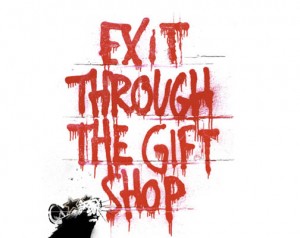Just who is the author of the doco Exit Through The Gift Shop wonders Michael Hutak. And does it really matter?
I wanted to approach this doco with the barest of prior knowledge, to consume the film as a self-contained text, outside the frame of its marketing and pre-publicity. All I knew was it was “about” the celebrated British street artist, Banksy, and it was the hot ticket at this year’s Sydney Film Festival. I think this is where I’m meant to say: “Warning, spoiler alert!” EXIT is not overtly about Banksy at all, but is instead presented as a portrait of Thierry Guetta, video diarist of the so-called street art scene in the noughties in Europe and LA, more recently the dubious artist-come-lately dubbed “Mr Brainwash”. At least this is the surface gambit of the production. Scratch the surface and all certainty is destabilised.
Thierry is a French expat in LA who made his bundle in the 80s arbitraging vintage clothing to Santa Monica’s hip and wealthy. With enough resources to indulge himself, we follow his obsessive journey of discovery, first assisting various prominent LA street artists such as Shepard Fairey, documenting their exploits on literally hundreds of hours of tape, then to his association with Banksy, which encompasses stalking, idolising, copying and mimicking; and finally to his career move into artist himself and his subsequent “triumph” at his first monster exhibition in LA, where bad Banksy “copies” and Pop Art pastiches couple with canny marketing to net the wily Thierry millions in sales and a priceless cache in the litany of art world curios.
Thierry is presented thoughout as a lovable dill with OCD, energetic but a figure of ridicule, and not really a bona fide artist, according to the “real” artists Banksy and Fairey; apparently because Thierry is patently not a “genius”, didn’t pay his dues but instead won instant fame through marketing, and is just generally not as narcissistic as his confreres. It is telling that when Thierry first meets Banksy on camera, much is made by the latter’s elves of the fact that Banksy had never let a camera in the studio before. Scary.
I love Banksy’s work without reservation, more for its wit and political content than the detail or daring of its execution. In EXIT, the character “Banksy” is presented as part Scarlet Pimpernel, part counter-cultural guerilla, always shot in the shadows, voice disguised, but it’s not at all clear what’s at stake in this preservation of anonymity. Would the works be any less compelling? No, not for me, but for Banksy it is clear the cloak and dagger approach is all part of the marketing of the artist persona. Indeed marketing the artist’s persona is a constituent part of the art. It’s core business in building the brand, and of course the brand itself is the artists’ overarching project per se, ad infinitum. There’s nothing new here — not that there’s anything wrong with that.
However in amongst all the smoke and mirrors, it would have been nice to see the street art milieu placed in some historical context There are no references are made to, say, the history of propaganda or political art, or the agit-prop strategies of the Russian avant garde; or more latterly to the Situationist tactics of detournement and derive which Banksy and his cohort so embrace, nor the style and content of the student poster art of May ‘68, or even the early 80s hip-hop phenomenon of bombing and graffiti art, which has trod this ground into mud for three decades now. None of this is figured. Neither is there any cogent analysis of the individual work itself. Instead street art is presented a form of phantom performance, engaged upon in secret by naughty boys (and one woman), fuelled by the cheap thrill of possible capture, underscored by the illicitness of simple law-breaking rather than any more radical creative transgression. And street art’s practitioners seem happy to buy into the critical notion that art is “not about the money”, and is driven from the street by an avant garde of special people with special insight. They call themselves artists. But while they may use the public space as their canvas, in the end it’s always about them, with the public just there to annoint their self-love.
The word “genius” crops up in EXIT with uncomplicated regularity, without much consideration that one man’s genius might be just another’s obsessive narcissism. Perhaps that’s the point.
This film is entertaining at times, is often funny and hypes up the street art scene into the status of “phenomenon”. And afterwards the punters were happy on their exit through the foyer, although several impromptu vox pops suggested there was some suspicion that this doco was actually a mocko, that the character of Thierry is a complete hoax, that he never produced any of his works, that he is in fact a stand-in for and the complete invention of Banksy and Fairey. This is quite possible and is indeed the suspicion of many commentators. Certainly there are no extant independent authorities in the film: no dealers, or critics offering any comment or otherwise. Banksy and Fairey are listed as directors. We all know the potential of film to lie at 24 frames per second, a potential accelerated by the conventions of the truth telling genre: documentary.
EXIT THROUGH THE GIFT SHOP may be just such a web of deceit …or it may not. I’m sure “all will be revealed” in the fullness of time. Either way I couldn’t care less. If the joke is on us, then it’s really on them. I’m sick to death of onanistic ironists posing for the spectacle only in search of its reflected glory. In the end, I prefer the art itself to these arcane games of whodunnit.
That said, sure, this movie is a bit of fun, if that’s your caper.
EXIT THROUGH THE GIFT SHOP, (2010)
Directed by Banksy, Screening at the Sydney Film Festival



Banksy’s anonymity is one of the major factors of his art fame. The outlaw culture of the graffiti scene, the pseudonyms and the signature images all play into the idea that this is art that exists outside the art world [‘not quite art’ as whatshisface says]. If Banksy was known as ‘an artist’ rather than a brand it’d spoil the whole vibe. Word in the UK is that’s he’s some spoiled rich kid with delusions of street cred. Personally I’d rather not know.
Banksy always reminds me of his Australian counterpart Stormie Mills. Both of them got into their unique creative process because they struggled with classic graffiti techniques and found that they excelled at a modified form that maintained the message of other graffiti. Banksy isn’t so much a brand as a reflex action. He and Stormie have both left the street so far behind (irrelevant of their works physical locale) that its not really relevant to their art anymore.
It was great. Humour, passion, enigmatic characters,history of graffiti,and a belly laugh at the LA Art scene. Do I believe Mr Brainwash broke his leg – yep – that’s the artist life, when the going get bad, then it just gets worse. Personalizing the prints with a spray can while being pushed in a wheel chair was hilarious. If Banksy wanted me to laugh it worked. I’m still smiling.
“If the joke is on us, then it’s really on them. I’m sick to death of onanistic ironists posing for the spectacle only in search of its reflected glory. In the end, I prefer the art itself to these arcane games of whodunnit.” I have to say, you really can’t put it better than that. I’m in irony overload. I was wondering the other day if irony in the end works in circular motion (as some say political persuasions do) or spirals in on itself? If it did in the former, it might end at some state of more highly evolved sincerity, but in the latter, a useless pin-point of abstract supremacy?
Pingback: Special Edition | The Art Life
There’s no way Thierry was acting. No way. That’s his character – no doubt about it.
Perhaps he was ‘set up’ by Banksy, but clearly there is too much authenticity in all of it to be completely a hoax.
Perhaps Thierry was to some extent ‘in’ on it … but even then – it’s clear, with the broken foot – all the extra people – that this would was not a total hoax.